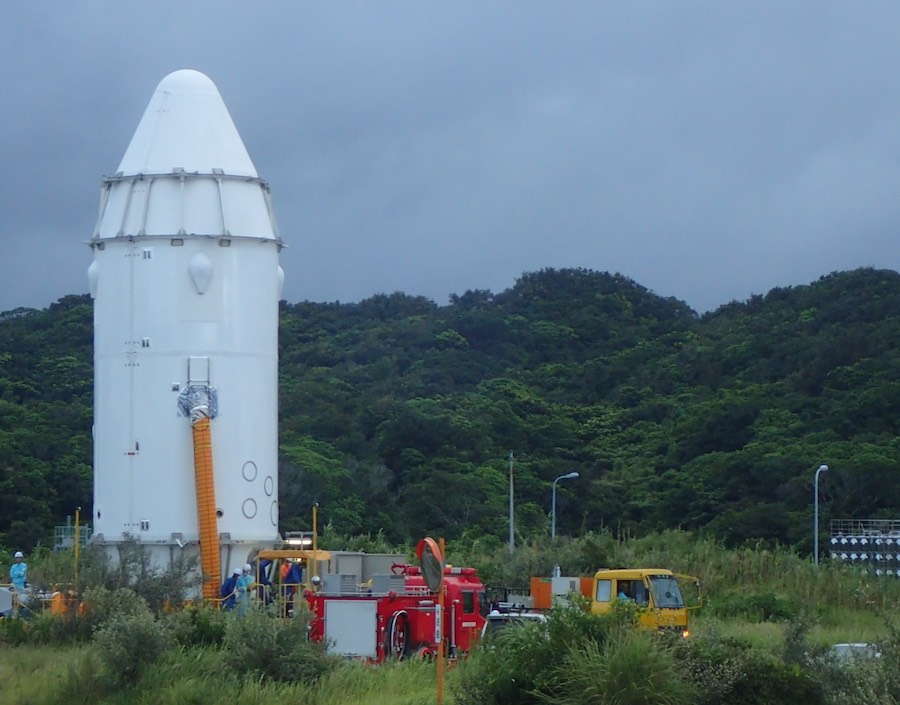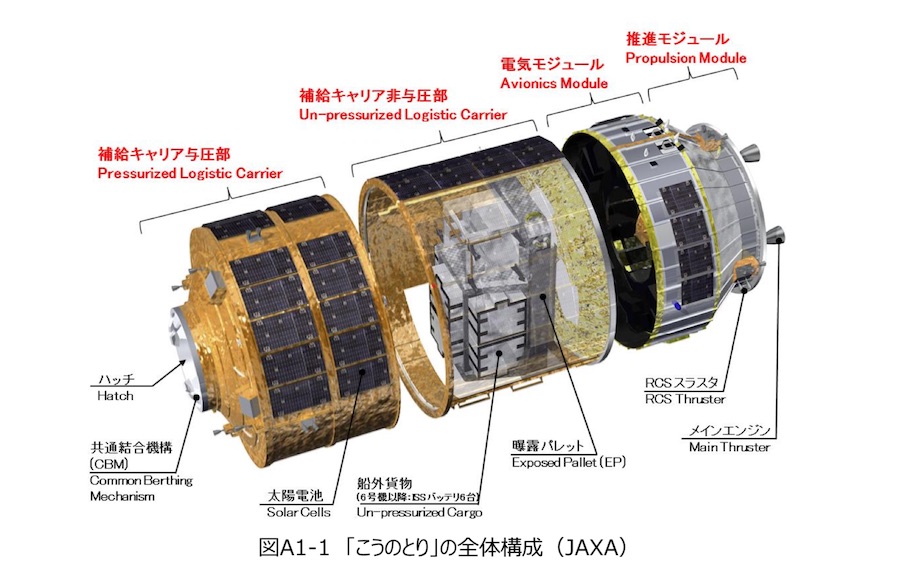Japan set to launch space station resupply mission – Spaceflight Now

A Japanese HTV cargo freighter is set for launch Tuesday (U.S. time) aboard a powerful H-2B rocket, ferrying six new lithium-ion batteries, a Sony-developed laser communications terminal, fresh water and other equipment to the International Space Station.
The unpiloted cargo ship is set for liftoff at 2133:29 GMT (5:33:29 p.m. EDT) Tuesday from the Tanegashima Space Center, a spaceport carved from rocky outcrops overlooking the Pacific Ocean.
A Mitsubishi Heavy Industries H-2B rocket will haul the HTV supply ship, also known as Kounotori 8, into orbit on a 15-minute flight heading southeast over the Pacific.
Liftoff is set for 6:33 a.m. Japan Standard Time on Wednesday, roughly the moment Earth’s rotation brings the Tanegashima launch complex under the space station’s orbital plane.
The mission will be the eighth cargo flight to the space station by a Japanese H-2 Transfer Vehicle since 2009.
The 186-foot-tall (56.6-meter) H-2B rocket is set to roll out Tuesday to Launch Pad No. 2 at Tanegashima, where launch crews will connect the vehicle’s mobile transporter to ground electrical and fluid supplies. Super-cold liquid hydrogen and liquid oxygen, which will power both stages of the H-2B launcher, will begin flowing into the rocket in the hours before liftoff.
The rocket’s two first stage LE-7A main engines will ignite in the final seconds of the countdown, followed by ignition of four strap-on solid rocket boosters to propel the launcher off the pad with 2.5 million pounds of thrust.
The H-2B’s guidance computer will turn the rocket toward the southeast to align with the space station’s orbital plane, and the rocket’s four strap-on boosters will burn out and jettison around two minutes after liftoff. The H-2B’s nose fairing, which will shield the HTV supply ship in the early phases of the mission, will separate at around T+plus 3 minutes, 40 seconds.
The rocket’s first stage engines will shut down just shy of the six-minute mark on the mission, followed be stage separation seconds later. A single LE-5B engine on the second stage will ignite and ramp up to more than 30,000 pounds of thrust for a burn set to last more than eight minutes.
The second stage engine will accelerate the HTV supply ship into a preliminary orbit ranging nearly 200 miles above Earth. Deployment of the the HTV cargo craft is planned approximately 15 minutes after liftoff.

An on-target launch will set up the Kounotori 8 spacecraft for a four-day pursuit of the space station.
Packed with some 8,326 pounds (3,777 kilograms) of equipment, experiments and crew provisions, the Kounotori 8 spacecraft will approach the space station in autopilot mode Saturday. The space station crew will use the lab’s Canadian-built robotic arm to capture the HTV supply ship around 7 a.m. EDT (1100 GMT) Saturday, then bring the spacecraft to a berthing port on the station’s Harmony module.
The six-person crew inside the station will get to work unpacking 5,313 pounds (2,410 kilograms) of cargo inside the HTV’s pressurized logistics carrier. Meanwhile, robots outside the station will extract a pallet from the HTV’s unpressurized cargo bay containing six lithium-ion batteries to upgrade the space station’s power system.
Astronauts Nick Hague and Andrew Morgan on the space station will conduct at least two spacewalks — the first is set for later this month — to begin installing the fresh batteries, which will replace aging and less-capable nickel-hydrogen batteries on the P6 solar array module on the far port side of the station’s truss backbone.
The Kounotori 8 mission will deliver the third set of six lithium-ion batteries to upgrade the space station’s four huge U.S.-built external power modules, each of which features solar array wings that span 240 feet (73 meters) tip-to-tip. The sixth HTV mission in 2016 carried the first set of new batteries to the station, followed by a second batch last year on the Kounotori 7 resupply mission.
A final set of six batteries will launch on the ninth HTV flight next year.
Each solar array section powers two electrical channels with 12 charging nickel-hydrogen batteries, and NASA is replacing the old batteries in power truss section with six lighter, more efficient lithium-ion batteries.

JAXA uses the HTV missions as part of its contribution to the space station program. Nicknamed Kounotori, which means “white stork” in Japanese, the cargo freighter measures about 33 feet (10 meters) long and about 14 feet (4.4 meters) in diameter.
The Kounotori 8 mission is also carrying food, fresh drinking water, a high-pressure gas tank to recharge the space station’s internal atmosphere with oxygen and nitrogen, and spacewalking tools.
The HTV will also deliver experiments to the space station.
One of the experiments will demonstrate a high-speed satellite laser communications system developed by JAXA and Sony Computer Science Laboratories. The technology demonstrator will test a laser link with a ground station, which can accommodate higher-bandwidth communications than radio systems.
“This technology, which employs a laser for in-orbit mass-data communication, will likely be widely used not only in the telecommunications industry, but in the future as a means of communication in the field of exploration,” said Koichi Wakata, a JAXA vice president, in a statement. “Specifically, it can be used as a means of communication between the Earth and the International Space Station, the moon, and Mars. There is a wide range of potential applications, such as communication with the moon rovers.”
The Small Optical Link for International Space Station, or SOLISS, experiment will be mounted on an experiment platform outside the space station’s Japanese Kibo laboratory module.
“Sony CSL is taking advantage of the in-orbit demonstrations to complete our long-distance laser communication system,” said Hiroaki Kitano, president of Sony CSL. “It will be the first step for Sony to build upon the results of these demonstrations and put it into practical use in society as we commercialize it.
“The opportunity to use Kibo for the in-orbit demonstrations makes it possible to greatly advance the research and development of the optical communication system, much more quickly than if we had launched a small satellite for the same purpose on our own,” Kitano said. “The SOLISS system is built using consumer components. After the demonstrations, we will retrieve the SOLISS unit and perform follow-up analyses, which we expect will further accelerate our commercialization process.”
Japan’s Hourglass experiment is also set for launch on the eighth HTV mission to help scientists investigate the behavior of soil and rock particles under low gravity, simulating the conditions future probes might encounter on a small planet or asteroid.
New hardware for a cellular biology experiment rack will also fly to the space station on the Kounotori 8 spacecraft, expanding the station’s capabilities for biological research.
Three CubeSats are also set to ride to the station inside the Kounotori 8 spacecraft. Once they arrive at the station, astronauts will transfer them to the Japanese Kibo module, where they will install them into a deployer for release into orbit through an airlock.
The 2-pound (1-kilogram) NARSSCube 1 nanosatellite was developed by Egypt’s National Authority for Remote Sensing and Space Science in partnership with the Kyushu Institute of Technology in Japan. It carries a low-resolution imaging camera.
The AQT-D CubeSat, which weighs 8.1 pounds (3.7 kilograms) and is about the size of a shoebox, will demonstrate a water-based satellite propulsion system. The AQT-D mission is led by the University of Tokyo.
Rwanda’s first satellite, named RWASAT 1, will also launch Tuesday. Officials say the satellite will aid agricultural and environmental monitoring.
Email the author.
Follow Stephen Clark on Twitter: @StephenClark1.






